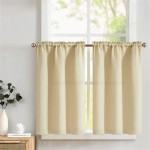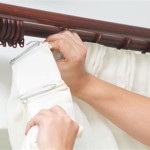Best Shower Curtain Rods for Tile: A Comprehensive Guide
Selecting the appropriate shower curtain rod for a tiled bathroom presents unique challenges. The smooth, often non-porous surface of tile necessitates careful consideration of installation methods and weight-bearing capacity to avoid damage. Choosing the right rod not only ensures the shower curtain hangs securely but also safeguards the integrity and aesthetic appeal of the tiled walls. This article provides a detailed exploration of the factors to consider when selecting a shower curtain rod for tile, highlighting the best options and offering practical advice for installation.
Understanding the Challenges of Installing Shower Curtain Rods on Tile
Tile, while durable and visually appealing, presents specific difficulties when it comes to installing fixtures like shower curtain rods. The primary issue is the potential for cracking or chipping the tile during drilling. Unlike drywall or wood, tile is hard and brittle, requiring specialized drill bits and precise techniques. Improper installation can lead to costly repairs and a compromised shower area. Furthermore, the smooth surface of tile makes adhesion-based installation methods, such as suction cups, less reliable over the long term, especially with heavier curtains.
Another consideration is the type of tile used in the shower. Ceramic tile, porcelain tile, and natural stone tiles (such as marble or granite) have varying degrees of hardness and require different approaches to drilling. Porcelain tile, for instance, is denser and more challenging to drill through than ceramic tile. Understanding the specific properties of the tile is crucial for selecting the appropriate installation method and hardware.
The weight of the shower curtain also plays a crucial role. Heavier curtains, such as those made of thick fabric or those with liners, place a greater strain on the rod and its mounting hardware. This increased weight can exacerbate any weaknesses in the installation, potentially leading to the rod detaching from the wall and causing damage to the tile.
Types of Shower Curtain Rods Suitable for Tile
Several types of shower curtain rods are available, each with its advantages and disadvantages when used with tile. The selection of the best option depends on factors such as the tile type, the weight of the curtain, and the desired aesthetic.
Tension Rods: Tension rods rely on pressure to hold them in place between the shower walls. These are generally considered the easiest to install, as they require no drilling. However, their suitability for tile is limited due to concerns about slippage and stability, especially with heavier curtains. The smooth surface of tile offers minimal friction, making tension rods prone to sliding, particularly when the curtain is pulled or tugged. While some tension rods have rubberized or textured ends to improve grip, they may still not be sufficient for heavier curtains or high-traffic showers.
Fixed Mount Rods: Fixed mount rods are secured to the wall with screws and anchors. These offer greater stability and weight-bearing capacity than tension rods, making them a more reliable option for tiled showers. However, installation requires drilling, which, as previously mentioned, poses a risk to the tile. Choosing the right drill bit and employing proper drilling techniques are essential to minimize the risk of cracking or chipping the tile.
Curved Shower Curtain Rods: Curved shower curtain rods provide additional elbow room in the shower, enhancing the showering experience. They are typically fixed mount rods and therefore share the same installation challenges as standard fixed mount rods with regards to tile. The added projection of a curved rod also increases the leverage exerted on the mounting points, making a secure installation even more critical.
Corner Shower Curtain Rods: Corner showers present unique challenges due to the angle of the walls. Corner shower curtain rods are specifically designed to fit these spaces and are typically fixed mount rods. Careful planning and precise measurements are essential for installing a corner shower curtain rod on tile, as any miscalculation can lead to misalignment and difficulty in securing the rod.
Key Considerations for Installation on Tile
Regardless of the type of shower curtain rod chosen, certain principles should be followed to ensure a successful and damage-free installation on tile.
Selecting the Right Drill Bit: The most important factor in drilling through tile is using the correct drill bit. Standard drill bits designed for wood or metal will quickly dull and are likely to crack the tile. Specialized drill bits for tile, such as diamond-tipped or carbide-tipped bits, are specifically designed to cut through the hard surface without causing damage. Diamond-tipped bits are generally considered the best option for harder tiles like porcelain or granite, while carbide-tipped bits may suffice for softer tiles like ceramic.
Using Proper Drilling Technique: Even with the right drill bit, improper drilling technique can still damage the tile. Start by marking the drill point with a pencil and applying masking tape over the area to prevent the bit from slipping. Begin drilling at a slow speed and with light pressure. Gradually increase the speed and pressure as the bit penetrates the tile. Avoid using the hammer drill function, as this can easily crack the tile. If the tile is particularly hard, consider cooling the drill bit with water to prevent overheating and damage.
Choosing the Right Anchors: Once the holes are drilled, selecting the appropriate anchors is crucial for ensuring the rod is securely mounted. Plastic anchors are generally not recommended for tile, as they may not provide sufficient grip, especially with heavier curtains. Metal anchors, such as toggle bolts or screw anchors, offer greater strength and holding power. Ensure that the anchors are sized appropriately for the screws and the thickness of the tile and wall. Consider using anchors specifically designed for use in tile or masonry.
Addressing Grout Lines: Drilling into grout lines is generally discouraged, as grout is more prone to crumbling and cracking than tile. If possible, position the mounting points to avoid grout lines. If drilling into a grout line is unavoidable, use a grout saw to carefully remove a small section of the grout before drilling. This will help prevent the grout from chipping and cracking during the drilling process. After installing the anchors, fill the gap around the mounting hardware with a waterproof sealant to prevent water from seeping behind the tile.
Alternative Installation Methods
While drilling is the most common method for installing fixed mount shower curtain rods, alternative methods may be considered in certain situations to avoid damaging the tile.
Adhesive Mounting: Some shower curtain rods are designed to be mounted using strong adhesive strips or pads. These adhesive mounts can be a viable option for lightweight curtains on smooth, non-porous tile surfaces. However, their long-term reliability is questionable, especially in humid shower environments. Furthermore, adhesive mounts may not be suitable for heavier curtains or in areas where the rod is likely to be subjected to significant stress.
Caulking and Bonding Agents: While not a primary mounting method, caulking and bonding agents can be used to supplement other installation techniques. Applying a bead of waterproof caulk around the base of the mounting hardware can help to seal the area and prevent water from penetrating behind the tile. Bonding agents, such as epoxy, can be used to adhere mounting brackets to the tile surface, providing additional support. However, these methods should be used in conjunction with other mounting techniques, such as drilling and anchoring, rather than as a standalone solution.
Popular Shower Curtain Rod Options for Tile
Several shower curtain rods are specifically designed or marketed for use with tile, offering features that enhance stability and ease of installation.
NeverRust Aluminum Shower Curtain Rods: These rods are made from rustproof aluminum, making them ideal for humid shower environments. They are typically fixed mount rods and come with mounting hardware suitable for tile. The lightweight nature of aluminum reduces the risk of the rod pulling away from the wall, even with heavier curtains.
Moen Adjustable Curved Shower Curtain Rods: Moen offers a range of curved shower curtain rods that are designed for easy installation and secure mounting on tile. These rods often feature adjustable lengths and concealed mounting hardware for a clean and professional look. The curved design provides additional shower space, enhancing the overall showering experience.
Zenith Tension Shower Curtain Rods with Grip Pads: While tension rods are generally not the preferred option for tile, Zenith offers models with enhanced grip pads that provide greater stability and prevent slippage. These rods are suitable for lightweight curtains in showers where drilling is not desired or possible. The grip pads are designed to distribute the pressure evenly across the tile surface, minimizing the risk of damage.
Maintaining Tiled Shower Walls After Installation
After installing a shower curtain rod on tile, regular maintenance is essential to prevent water damage and ensure the longevity of the installation.
Inspecting for Leaks: Regularly inspect the area around the mounting hardware for any signs of leaks. Water penetration behind the tile can lead to mold growth and structural damage. If leaks are detected, re-caulk the area around the mounting hardware to create a watertight seal.
Cleaning the Tile and Grout: Clean the tile and grout regularly to prevent the buildup of soap scum and mildew. Use a non-abrasive cleaner and a soft brush to scrub the tile and grout. Avoid using harsh chemicals or abrasive cleaners, as these can damage the tile and grout.
Tightening Mounting Hardware: Periodically check the tightness of the screws and anchors. Over time, the screws may loosen due to vibration or changes in humidity. Tighten the screws as needed to ensure the rod remains securely mounted.
Choosing the right shower curtain rod for tile requires careful consideration of the tile type, the curtain weight, and the installation method. By selecting the appropriate rod and employing proper installation techniques, homeowners can ensure a secure and aesthetically pleasing shower area without damaging the tile. Regular maintenance will further prolong the life of the installation and prevent water damage.

The Best Shower Curtain Rods Tested

How To Install A Shower Curtain Rod On Tile Wall Sima Spaces

10 Best Shower Curtain Rods 2025 Top Picks

10 Best Shower Curtain Rods 2025 Top Picks

Allen Roth 44 In To 72 Matte Black Fixed Or Tension Single Curve Adjustable Shower Curtain Rod Shlsnc01mb At Com

The Best Shower Curtain Rods Tested

Zenna Home Neverrust 50 In To 72 Aluminum Dual Mount Curved Shower Curtain Rod Brushed Nickel 72s2albnl The

Moen 60 In To Old World Bronze Fixed Double Curve Shower Curtain Rod At Com

10 Best Shower Curtain Rods 2025 Top Picks

Top 5 Best Shower Curtain Rods For Tile Review Rod Holder Ceramic 2025








